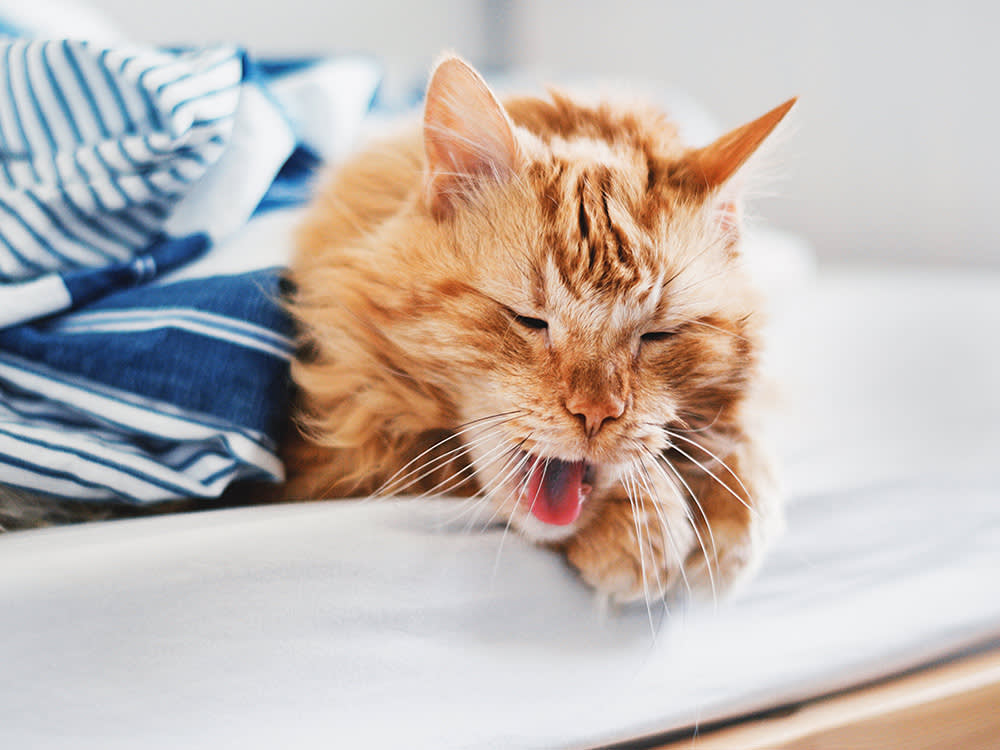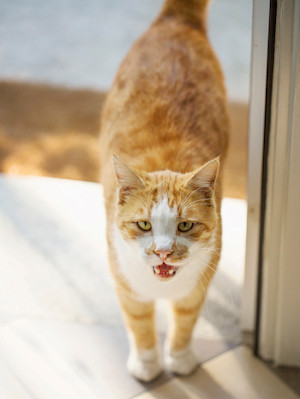How to Help an Asthmatic Cat Breathe Easy
Everything you need to know about feline asthma, from someone who’s been there

Share Article
If you’d told me five years ago I’d be administering an asthma inhaler to a cat every morning before even having a cup of coffee, I would have told you that you’re crazy. But here I am, gently holding a mask up to the snout of my 19-year-old tabby cat, Kip, as I count the breaths he takes from his inhaler.
The first few times I heard Kip coughing, I thought he must be trying to dislodge a hairball. But when he did it a few days in a row with no hairball in sight, I knew he need to be checked out by a vet. While it was scary at first to receive the diagnosis of asthma, which is incurable, at almost 20 years of age he’s a testament to how cats with well-managed asthma can go on to lead normal lives.
What is feline asthma?
Feline asthma is thought to affect 85,000 cats in the UKopens in new tab, making it the most commonly diagnosed feline respiratory illness. While cats of all ages can suffer from asthma, a majority of cases develop in those two to eight years of age.
As with humans, asthma in cats is a condition characterised by inflammation of the lungs (specifically the bronchi), airway spasms and excess mucus production, making it harder to get oxygen from each breath. This can result in an asthma attack, which is often characterised by coughing, open mouth breathing, wheezing, and rapid or laboured breathing.
Dr Annette Louviere, a licensed veterinarian specialising in cats and an active member of the American Association of Feline Practitioners, clarifies that, “Not all cats present with an active cough, which is why it’s important to discuss any concerns with your veterinarian. Catching feline asthma early and implementing appropriate management will help reduce permanent secondary effects which can occur – like tissue scarring and emphysema.”
A cat who suffers from an asthma attack may appear to be perfectly healthy in every other way. Your cat could be playing with their favourite catnip toy or relaxing in a sun puddle when a sudden onset of symptoms occurs, putting them in respiratory distress.
What causes feline asthma?
While it is believed that genetics play a role in determining which cats are more susceptible to developing asthma, allergens and stress can trigger and worsen attacks. Common allergens include smoke (tobacco, fireplace, cigarette), mould, pollen from trees and flowers, dust mites, cleaning solutions, dusty kitty litter, aerosol sprays and grass. You may be surprised to learn that even indoor cats can suffer from hay fever like we do.
Stress is another factor to consider. “I’ve seen cats whose owners have never seen them experience difficulty breathing at home display symptoms at the vet’s office from stress,” says Dr Hyla Gayer, co-Medical Director at West Chelsea Vet in New York City. Stressors can be something as small as a vacuum cleaner or a large life event like moving into a new home.
How can I tell if my cat suffers from asthma?
Laboured, rapid and open-mouth breathing, coughing and wheezing can be signs of asthma in your cat. You may notice your cat crouching low to the ground and coughing with their neck outstretched,” says Dr Gayer. If you notice your cat doing this multiple times a week without any signs of a hairball, your cat may be suffering from asthma.
“When diagnosing feline asthma, it’s important to rule out other conditions which can cause similar clinical signs. Performing blood tests, urinalysis and faecal testing can help rule out other potential causes,” explains Dr Annette Louviere. “Taking radiographs (X-rays) can be useful as some cases will show a pattern within the cat’s lungs that is characteristic of accumulating inflammatory cells or overinflation due to constricted airways.”
If the results from those tests are inconclusive, your cat may need undergo anaesthesia. “The way to definitively diagnose asthma is to do a transtracheal wash,” explains Dr Gayer, “We intubate them and flush sterile saline into the breathing tube and such it back up in order to collect cells to send to cytology.” In order to help your vet best assist your cat’s needs, be sure to alert them to any recent changes in your cat’s environment. If you can, bring a video of your cat during an attack, to help your veterinarian in their diagnosis.
What are the treatment options?
Feline asthma does not currently have a cure, but can be managed with medication and environmental changes. Corticosteroids (reduce inflammation) and Bronchodilators (widen airways) are medicines used to treat asthma in humans and cats alike. Corticosteroids in inhaler form are often preferred as a first line of defence, as they are not systemic and therefore have fewer side effects. But some cats – as is the case with 19-year-old Kip – may require a combination of oral and aerosol medications. Bronchodilators are more commonly used as a ‘rescue’ medicine to open up the airways quickly during a severe attack.
“Immunotherapy for allergies is being used in some feline asthma cases to help reduce the body’s response to allergens,” says Dr Annette Louviere. However, it isn’t advised to administer these therapies at home without supervision. “This is typically performed under the direction of a veterinary dermatologist, following intradermal skin testing.”
To keep your cat’s asthma attacks at bay, reduce allergens in your home. Keep your cat away from smoke and avoid spraying perfumes and other products (home freshener, hairspray). Replace their litter with a low or no-dust litter and speak with your vet about potential food allergies. Air purifiers are also recommended as a way to reduce allergens. If pollen is a trigger for your cat, keep the windows closed during allergy season.
With proper treatment and preventative measures, a cat with asthma can expect to lead a full and active life – take it from Kip.

Tamar Arslanian
Tamar Arslanian is founder of the popular blog IHAVECAT and author of the book Shop Cats of New York written-up in the New York Times, USA Today and New York Post. She has consulted pet brands on marketing and social media, written for numerous outlets (i.e., Buzzfeed, Dodo, Catster), and shares her home with two rescue cats and the occasional foster. For her day job, Tamar has served as vice president of account management at numerous high-profile New York City advertising agencies.
Related articles
![Siamese cat coughing]()
Why Is Your Cat Coughing?
You thought it was a hairball, but nothing’s coming up
![Red Cat On Threshold Looks At The Camera And Meows.]()
Why Is My Cat Heavy Breathing?
This can happen over time or very suddenly. Either way, it’s important to learn more about this symptom
Can Cats Actually Get the Common Cold?
They’re not exactly blowing their noses and rubbing Vicks on their chests, but here’s what you need to know
![Gray and white striped cat is scratching his ear]()
What’s Up With My Cat’s Skin?
Everything you need to know about cat allergies, according to three veterinary dermatologists
![brown cat in grass]()
Hairballs: A Tangled Web
What to do when your cat hawks one up





